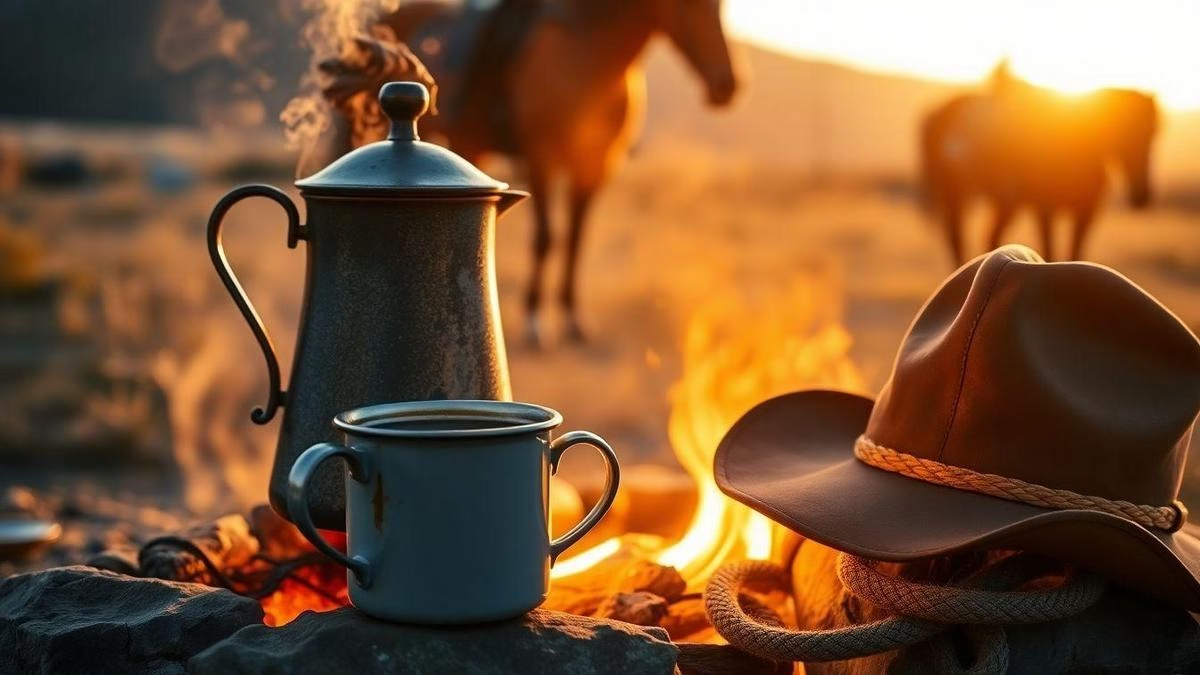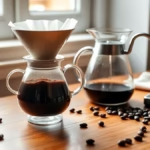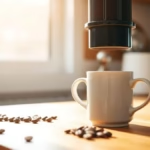How to Make Cowboy Coffee Without a Coffee Machine gives you a clear, friendly guide to no-filter camp coffee. You will learn how to pick the right bean and a coarse grind, a quick grind check, and the boil-and-settle method so grounds sink. You will learn which pots, kettles, scoops and lids to pack for campfire or stove, simple ratios, timing cues without a thermometer, and easy flavor tweaks like spices or milk. You’ll also get fixes for bitter or gritty cups and basic fire safety and cleanup. This guide helps you brew a bold, clean cup anywhere.
Key Takeaway
- Use coarse grounds to cut down on grit.
- Boil water then let it cool a bit before adding coffee.
- Stir in grounds and let the coffee steep a few minutes.
- Let grounds settle or sprinkle cold water to sink them.
- Pour slowly to keep grounds out of your cup.
Choose the right coffee and grind for your no-filter coffee brewing
Pick beans that match how bold you like your camp cup. Light roasts give bright, fruity notes; medium or dark roasts give chocolate and caramel. For no-filter methods like cowboy coffee, whole beans you grind just before brewing give the freshest flavor and the cleanest control over extraction.
Grind size is your main tool when you skip filters. Coarse to medium-coarse keeps big bits out of your mouth and slows extraction so the brew won’t go bitter fast. Coarser grounds settle faster and are easier to skim or ladle out. A small tweak to grind or steep time changes the whole cup, so experiment and note what you like. For more background on how roast and grind choices change extraction and taste, see how grind and roast affect flavor.
Cowboy coffee is simple: hot water, ground coffee, patience—and a little practice makes it sing.
Why a coarse or medium-coarse grind is best for cowboy coffee
Big grains extract more slowly, giving you time to steep without pulling out too many bitter compounds. Coarse pieces soak up flavor and sink, leaving most bitter oils behind. Coarse grinds also cut down on sediment. If you want more strength, try a slightly finer medium-coarse grind but shorten steep time.
| Grind size | How it behaves in cowboy coffee | Best steep time |
|---|---|---|
| Coarse (like kosher salt) | Sinks fast, less sediment, mellow cup | 3–5 minutes |
| Medium-coarse (like rough sand) | Stronger flavor, more body | 2–4 minutes |
How your bean roast and freshness change the taste
Roast level changes what you taste first. Light roasts are bright and acidic; dark roasts are richer and lower acidity. Freshness matters: beans roasted within two to three weeks pop with aroma and flavor. If beans are extremely fresh and gassy, rest them a few days before grinding.
Pack and use the right pots for campfire coffee or stovetop cowboy coffee
Choose a pot with a wide mouth for easy stirring and scooping. A tight-fitting lid helps control boil-overs and keeps grit out. Consider capacity and weight: solo trips fit 0.6–1 L; groups need 1.5–2 L. Cast iron holds heat but is heavy; titanium is ultralight but pricey. Bring a stable handle, a scrub pad, and a little biodegradable soap—clean pots make better coffee. For guidance on cooking over open flame and cookware safety, check these campfire cooking and cookware safety tips.
Which kettle or pot to bring for brewing without a machine
Pick a material that matches where you’ll cook. Stainless steel is durable and neutral; enamel looks classic; titanium is ultralight; cast iron is rugged and retains heat. Match the pot to your trip: long hikes favor light gear; car camping allows heavier pots.
| Type | Weight | Best for | Quick pros |
|---|---|---|---|
| Stainless steel pot | Medium | Car camping / camp stoves | Durable, easy to clean |
| Enamel coffee pot | Medium-high | Campfire with grill | Classic look |
| Titanium cup/pot | Low | Backpacking | Ultralight, fast heating |
| Cast iron kettle/pot | High | Group campfires | Retains heat, rugged |
How simple tools like a scoop and a lid help
A scoop keeps measurements consistent—aim 1–2 tablespoons per cup. Use metal or wooden scoops near open flame. A lid traps heat so grounds settle faster and slows the pour, helping hold back sludge. Bring a small metal strainer or a clean bandana to strain as you pour for a cleaner cup.
Safe cookware choices for open flame and stove use
Avoid non-stick pans and glued-on handles. Choose solid metal handles or removable ones and steer clear of plastic or rubber near flames. Keep a glove or cloth for handling hot metal.
A lid and a steady hand will save more coffee than a fancy machine. Simple habits beat gadgets when you’re brewing over fire.
Follow the boil, grounds, and settling method step-by-step
You can make good coffee with just a pot and heat. Start with clean water and coarsely ground coffee (coarse grounds sink faster and give less grit). A common ratio is about 1 tablespoon (7–8 g) of coffee per 6 ounces (180 ml) of water—measure roughly by eye outdoors.
Bring the water to a boil, add the grounds, and let it reach a light rolling boil for about 20–30 seconds. Take the pot off the heat and stir once to wet all grounds. Let it rest so heavier grounds settle to the bottom.
When grounds have mostly sunk, pour slowly and stop before the last inch or two of liquid so most sediment stays behind. With practice you’ll find the right grind, timing, and pour speed for your taste. For deeper reading on extraction and temperature control that inform the boil-and-settle approach, see the practical brewing methods and extraction guidance.
How to make cowboy coffee without a coffee machine using the boil-and-settle technique
How to Make Cowboy Coffee Without a Coffee Machine starts with a pot, a spoon, grounds, and a heat source. Heat water, add coffee, boil briefly, then let it rest until the grounds sink. Use a coarse grind to reduce bitter fines and help grounds drop faster.
A trick: after the pot rests, sprinkle about a tablespoon of cold water across the top. That quick chill helps floating grounds sink. Pour gently; use a small strainer or ladle if needed.
How long to boil then rest so grounds sink before pouring
Bring to a full boil first so water is hot enough to extract flavor. Once boiling, add grounds and return to a gentle boil for 20–30 seconds. Remove from heat and rest 3–5 minutes for most coarse grinds; if finer, rest 4–6 minutes but expect more sediment. The cold-water splash after resting helps floating specks sink.
| Step | What to do | Typical time |
|---|---|---|
| Heat water | Bring to full boil | 1–3 minutes (depends on heat) |
| With grounds | Boil lightly after adding grounds | 20–30 seconds |
| Rest | Let grounds settle off heat | 3–5 minutes |
| Settle aid | Splash cold water on top (optional) | 5–10 seconds |
How to pour slowly so grounds stay in the pot
Tilt the pot slowly and keep a steady stream, stopping before the last inch of liquid. If grit appears, pause and let more settle. For extra insurance, pour through a fine mesh or use a ladle to leave the last sludgy bit behind.
Use easy ratios, timing, and temperature to improve your cup
If you want to learn How to Make Cowboy Coffee Without a Coffee Machine, begin with a consistent water-to-coffee ratio and steady heat plan. Small adjustments to time and grind change the cup more than big guesses. Use a lid to keep heat steady and trust simple visual cues for temperature.
Aim for a 3–5 minute steep for most cowboy brews. For stronger coffee, add grounds or steep toward five minutes. For cleaner, brighter coffee, shorten the steep and use a coarser grind.
Simple water-to-coffee ratio tips for stovetop and campfire
A practical rule: 1 tablespoon of ground coffee per 6 ounces of water for medium strength; 2 tablespoons per 6 ounces for strong. For an 8-ounce mug, that’s roughly 1.25–1.5 tbsp for medium, 2.5 tbsp for strong. On a campfire, use a slightly coarser grind to avoid chalky over-extraction. For quick reference on standard ratios and common tips you can apply outdoors, see standard brewing ratios and general tips.
| Method | Water : Coffee (per 8 oz) | Grind | Steep time |
|---|---|---|---|
| Stovetop Cowboy | 8 oz : 1.5 Tbsp (medium) — 8 oz : 2.5 Tbsp (strong) | Medium to medium-coarse | 3–5 min |
| Campfire | 8 oz : 1.25 Tbsp (medium) — 8 oz : 2 Tbsp (strong) | Medium-coarse | 3–5 min |
Quick tip: If you want grounds to settle faster, add a splash (about 1 tablespoon) of cold water on top after steeping.
How cooling time and gentle stirring affect strength
Let the boil die down for 20–30 seconds before adding grounds to avoid harsh extraction. Stir gently once or twice after adding coffee to wet grounds evenly; over-stirring brings up fines and can make the brew bitter. Then leave the pot undisturbed so grounds can settle.
Handy timing cues if you don’t use a thermometer
Watch bubbles and steam. Bring water to a full boil, pull off heat and wait 20–30 seconds—usually the right temperature to add grounds. Steep 3–5 minutes, then let grounds settle 1–2 minutes before pouring.
Try cowboy coffee recipe variations to suit your taste
Cowboy coffee is forgiving. Change grind, dose, or boil to move flavor. Coarse grounds settle faster and give less grit; finer grounds are stronger but sludgier. Try a 1:15 to 1:12 coffee-to-water ratio, then nudge by a scoop at a time.
Add butter or coconut oil for a creamy mouthfeel, or a pinch of salt to reduce harsh edges. Roast level and bean origin also affect the cup: light roasts brighten, dark roasts add smoke and body.
“At my first camp, an old ranger told me: don’t fuss too much — patience and good beans make the best cup.”
How to add spices, sweeteners, or milk to no-filter brewing
Add spices with the grounds so they steep together. For a 12-oz cup, start with 1/4–1/2 tsp cinnamon or a crushed cardamom pod. Toast whole spices briefly in the pot before adding water. Wrap spices in a small muslin bag for cleaner flavor.
Add sweeteners while hot so they dissolve. Warm milk separately and add at the end. Sweetened condensed milk gives a rich cup; plain milk softens acidity.
| Addition | When to add | Amount per 12 oz | Flavor effect |
|---|---|---|---|
| Cinnamon (ground) | With grounds | 1/4–1/2 tsp | Warm, sweet spice |
| Cardamom (crushed) | With grounds | 1 pod | Floral, citrus lift |
| Cocoa powder | With grounds | 1/2–1 tsp | Chocolate depth |
| Salt | With grounds or pinch at end | Pinch | Cuts bitterness |
| Sweetened condensed milk | After brewing | 1–2 tbsp | Creamy, sweet |
How to change strength and flavor without a coffee maker or filter
Strength is ratio and time. To strengthen, add more coffee or steep longer. To weaken, shorten steep or dilute with hot water. Let water cool slightly off the boil before adding grounds to reduce bitterness. For a cold option, do a 12–18 hour cold steep in a covered jar and strain.
Ways to strain or clarify a gritty cup
Let the pot sit so grounds sink, pour slowly, and stop before the last dregs. Use a bandana, fine mesh, or even a clean sock as a makeshift filter. Cracking a clean eggshell into the pot during brewing can help clump fines and clear the cup.
Troubleshoot common problems and stay safe outdoors
Common outdoor issues: bitterness, grit, floating grounds, and uneven heat. Control heat and timing. If the pot boils hard with grounds, the coffee scorches and tastes bitter. If grind is too fine, you’ll get sludge. Use coarse grounds and watch the pot.
Quick fixes: let grounds settle longer, pour slowly, strain through cloth or mesh, and keep gear clean and dry. Safety: keep distance from flames, use long handles or tools, wear gloves, and fully douse the fire before leaving. For official guidance on campfire rules and safe practices, see official campfire safety and rules.
A good camp cup starts with patience: let the grounds settle and the heat calm down before you pour.
How to avoid bitter or gritty coffee when you boil grounds
Bring water to a gentle boil, remove from heat, add coarse grounds, stir once, and steep 3–4 minutes. Avoid a rolling boil after grounds are in. Use coarse grind and about 2 tablespoons per 8 ounces as a starting point. After steeping, add a small pinch of cold water to help grounds sink, then pour slowly.
What to do if grounds keep floating when you make cowboy coffee without a coffee machine
Floating grounds come from oils and fines. Let the pot sit 4–6 minutes after steeping. Crack an eggshell into the coffee while it steeps to help clump fines, or strain as you pour with a bandana, sock, or metal strainer.
| Problem | Likely cause | Quick fix |
|---|---|---|
| Bitter taste | Water boiled too long with grounds | Remove from heat at scald, steep 3–4 min |
| Gritty cup | Too fine a grind or no settling | Use coarse grind, wait 4–6 min, decant slowly |
| Floating grounds | Oils or fine particles | Let rest, skim or strain while pouring |
Fire safety and cleanup tips
Douse embers with plenty of water, stir ashes until cool, and feel for heat before you leave the fire pit. Pack out coffee grounds and trash—don’t dump grounds near water sources. Clean your pot with minimal soap, rinse well, and store dry.
Quick FAQ — How to Make Cowboy Coffee Without a Coffee Machine
- Q: What grind should I use?
A: Coarse to medium-coarse is best for How to Make Cowboy Coffee Without a Coffee Machine—fewer fines, less grit, and gentler extraction.
- Q: How long do I steep?
A: Usually 3–5 minutes off the heat after a short 20–30 second light boil with grounds.
- Q: How do I avoid a gritty cup?
A: Use coarse grind, let grounds settle 4–6 minutes, pour slowly, or strain through a bandana or mesh.
Conclusion
You’ve got everything you need to brew a great camp cup: keep a coarse grind, use the boil-and-settle trick, cover the pot with a lid, and pour slowly. Small tools—a scoop, a tight-mouthed pot, or a simple strainer—make a big difference.
Tweak one thing at a time: ratio, steep time, or grind. Practice will teach you faster than a long lecture; soon your cups will sing instead of stumble. If things go sideways, fix bitterness by cutting heat and time; deal with grit by coarsening the grind, waiting longer, or straining. And remember the basics: fire safety, clean gear, and packing out your trash keep the wilderness friendly for your next brew.
Ready for more recipes and outdoor coffee tricks? Swing by https://guiabebefeliz.com for more articles and inspiration.

Rafael Souza is a digital marketing specialist and passionate coffee enthusiast. He founded Guiabebefeliz to share practical, easy-to-follow guides for making great coffee at home without needing professional barista skills. His mission is to help readers enjoy better coffee experiences, one cup at a time.






